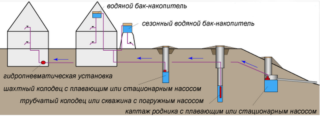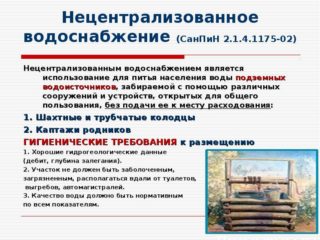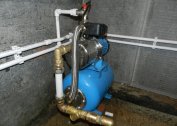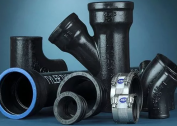SanPiN 2.1.4.1175-02 developed and compiled by doctors and candidates of sciences. Scientists from various state scientific institutions of Moscow, Saratov, Kazan, Chuvashia participated in the creation, with the participation of the SSES Department of the Ministry of Health of the Russian Federation. Registered on December 20, 2002, replaced the expired SP 2.1.4.554–96. It contains the rules for the sanitary and hygienic use of water not related to centralized sources.
General Provisions
 The regulation establishes a list of rules, guided by which it is necessary to comply with the rules for the construction, use and equipment of water intake facilities and territories around them.
The regulation establishes a list of rules, guided by which it is necessary to comply with the rules for the construction, use and equipment of water intake facilities and territories around them.
It is customary to call decentralized water intake for drinking and household needs, which is carried out by the population from sources located underground, and is carried out using the necessary technical devices.
The rules for using water bodies are mandatory for all categories of citizens. Control rests with the supervisory authorities of the sanitary services.
Location Requirements
 In order to prevent pollution from entering the water, preserving its quality properties, preventing chemical and bacteriological contamination and preventing the spread of waterborne infectious diseases among the population, the main role is played by the location of the water intake facilities.
In order to prevent pollution from entering the water, preserving its quality properties, preventing chemical and bacteriological contamination and preventing the spread of waterborne infectious diseases among the population, the main role is played by the location of the water intake facilities.
The site for the arrangement of the object is chosen by the owner of the site after earth surveys and on the basis of the final data obtained after the survey of the territory by specialists in hydrology.
To obtain approval, you must have the following data:
- groundwater flow direction in the terrain map
- thickness of aquifers and their depth;
- the probability of mutual use of existing water intakes and the use of surface waters of natural origin.
The results of the surveys should show information about the ecological and sanitary condition of the place of location of the water intake structure with marks on potentially dangerous objects for water use.
The location of the water intake should be away from landfills, more than 50 meters from potentially dangerous pollution sites, more than 30 meters from highways.
Device and hardware requirements
 Convenience, durability and the likelihood of contamination of the points of water intake are determined by the corresponding device design of water use facilities.
Convenience, durability and the likelihood of contamination of the points of water intake are determined by the corresponding device design of water use facilities.
The most commonly used structures for water intake in places of settlements:
- mine wells;
- tubular wells;
- capttations of springs and keys.
The number of people using a source of water supply varies in each case, depending on the debit of the source and the established norms of water consumption.
The construction of mine wells
Wells are constructed for the use of water in the first pressureless aquifer with sides in the form of a circle or square. Device:
- head end;
- trunk;
- water intake part.
The head has the function of preventing blockages, monitoring and serves as an auxiliary lift. According to the regulations, the height of the well should be seventy centimeters above the ground level. When arranging the head, it is necessary to mount a cover or cap made of reinforced concrete, which must be closed. A mounted shelter is mounted on top of the head.
Around the head, a clay castle with a size of 2 mx 1 m is prescribed and a concrete, stone, brick or asphalt blind area is installed in a radius of more than two meters with a slope of 10 cm in the direction from the well. Around the fence, and near the well bench for equipment.
The trunk is used to lift water in buckets, the walls must have good resistance to external loads. Reinforcement is done with concrete rings laid on cement.
In wood trunks, rot-resistant varieties are used:
- larch;
- alder;
- elm;
- oak.
The tree must be naturally dried for six months and well cleaned.
With the help of water intake, groundwater is sampled and accumulated. The structure is buried in the aquifer. For the possibility of repair, brackets are mounted in the walls, and for resistance to pollution, the bottom is covered with filtering gravel.
The device of tubular wells
 Wells are used to extract water from various depths. There are two types: Abyssinian, not exceeding 8 meters, and artesian - 100 and more meters. Device:
Wells are used to extract water from various depths. There are two types: Abyssinian, not exceeding 8 meters, and artesian - 100 and more meters. Device:
- casing;
- pump equipment;
- filter.
The head of such a well must be arranged 80-100 cm above the ground, sealed, having a drain and a casing, equipped with blind areas made of stone materials by analogy with mine wells.
When installing a tubular well, chemicals and components approved by the Ministry of Health of the Russian Federation for use in drinking and household conditions are used.
The device of captages of springs
 Captages are called chambers of various modifications for collecting water. Used for drinking water coming from the springs and springs.
Captages are called chambers of various modifications for collecting water. Used for drinking water coming from the springs and springs.
The chamber in the capture must contain a closed neck with the possibility of penetration, have pipes for emptying and ventilation. The place near the caption should be fenced.
The intake pipe is equipped with a crane and a hook, it should rise one and a half meters above the ground level from the capture. Nearby put a bench for inventory. At ground level, a tank is installed for overflowing excess water into the drain. The neck of the capturing chamber is insulated and displayed above the ground to a distance exceeding 80 cm.
Doors and hatches necessary for inspection and repair work should be arranged in the walls of the captive.
Water according to the properties of physico-chemical indicators should correspond to the table given in SanPiN 2.1.4.544-96 p.4.1. Exceptions in the form of changes to certain standards or inclusion of new ones are possible by decision of the Chief Sanitary Inspector on the basis of the conditions of a particular region, sanitary conditions and environmental conditions.
Requirements for maintenance and operation
The primary role in protecting drinking water from germs and chemical contamination is the proper content and use of the source.
Car washing, livestock maintenance, water use using chemicals in the household are allowed in a radius of more than 20 meters.
The withdrawal of water from the captive for private use is permitted using pumping equipment or a bucket attached to the captive. The use of buckets for personal use is prohibited.
Captage insulation should be carried out with environmentally friendly materials:
- hay;
- straw;
- sawdust;
- wood shavings.
It is important to exclude the entry of environmental insulation into the water intake system. The use of synthetic heaters and chemicals that are not approved by the Ministry of Health of the Russian Federation is prohibited.
Captures and wells are cleaned once a year at the request of SES bodies at the state’s expense. After cleaning, the system is flushed and treated with a chlorine-containing substance.
At the end of the service life of the structure due to wear, shallowing, water spoilage, the owner of the water intake must eliminate it. After liquidation and filling the well, it is necessary to erect a hill 20-30 cm high.


